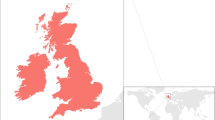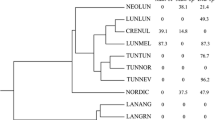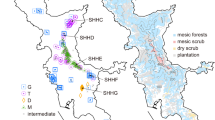Abstract
An analysis of the variation patterns in the three Pacific Coast maritime species ofAbronia (Nyctaginaceae) based on 95 population studies, is presented in the form of scatter diagrams. The relationship of this group of species to other members of the genus, such asA. gracilis Benth., is considered. Despite widespread evidence of hybridization and introgression, the three maritime species (A. latifolia Eschsch.,A. maritima Nutt. ex S. Wats., andA. umbellata Lam.) maintain their distinctness. Most of the taxonomic segregants in this group have been based on what appear to be hybrid or introgressed individuals, many of which closely resemble members of a series of artificial hybrids made in the greenhouse. The chromosome number of all three species is estimated as 2n = ca. 46. The species are shown to differ markedly in ecological preference:A. latifolia competing successfully on stable areas of dunes from Vancouver Island, British Columbia, to Santa Barbara Co., California;A. maritima being the major foredune former along the strand from San Luis Obispo Co., California, south to Nayarit, Mexico; andA. umbellata occurring on more stable dunes from San Luis Obispo to San Diego Co., California, and sporadically north and south of this area. The latter species is pollinated chiefly by nocturnal insects and is fragrant in the evening, whereas the other two have diurnal flowers. One widespread and two rarer, more northern subspecies ofA. umbellata are recognized in the taxonomic revision, while the other two species are not subdivided taxonomically.
Similar content being viewed by others
Literature Cited
Abrams, L. 1944. An Illustrated Flora of the Pacific States, Washington, Oregon, and California. Vol. 2. Stanford, California: Stanford Univ. Press. viii + 635 pp.
Anderson, E. 1949. Introgressive Hybridization. New York: John Wiley & Sons. ix + 109 pp.
Cooper, D. C. 1929. The chromosomes ofBuginvillaea [sic], Proc. Nat. Acad. Sci. U. S. A.15: 885–887.
— 1931. Microsporogenesis inBuginvillaea [sic]glabra. Amer. Jour. Bot.18: 337–358.
Cooper, W. S. 1936. The strand and dune flora of the Pacific Coast of North America: A geographic study. pp. 141–187.In: Goodspeed, T. H. (Editor). Essays in Geobotany in Honor of William Albert Setchell. Berkeley: Univ. California Press.
Jepson, W. L. 1914. A Flora of California. Part IV. San Francisco, California: H. S. Crocker Co. pp. 369–464. (Nyctaginaceae: pp. 451–459.)
Munz, P. A. 1958. California miscellany IV. Aliso4: 87–100.
— 1959. A California Flora. Berkeley & Los Angeles: Univ. California Press. 1681 pp.
—. 1949. California plant communities. Aliso2: 87–105.
Standley, P. C. 1909. The Allioniaceae of the United States, with notes on Mexican species. Contr. U. S. Nat. Herb.12: 303–389.
— 1918. Allioniaceae. North Amer. Flora21: 171–254.
Author information
Authors and Affiliations
Additional information
Based on a dissertation accepted in partial fulfillment of the requirements for the Ph.D. degree at Claremont Graduate School, Nov. 1959.
Rights and permissions
About this article
Cite this article
Tillett, S.S. The maritime species of Abronia (Nyctaginaceae). Brittonia 19, 299–327 (1967). https://doi.org/10.2307/2805531
Issue Date:
DOI: https://doi.org/10.2307/2805531




